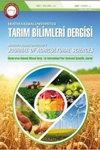运河几何,流速,达利草(Paspalum dilatatum Poir.)密度和土壤磷对植被渠系抗水力的影响
IF 1.1
4区 农林科学
Tarim Bilimleri Dergisi-journal of Agricultural Sciences
Pub Date : 2016-06-08
DOI:10.1501/TARIMBIL_0000001380
引用次数: 2
摘要
正常0假假假MicrosoftInternetExplorer4 Dallisgrass (Paspalum dilatatum Poir.)减少灌溉渠的流量,给灌溉渠的运维带来问题。研究了水草对植被沟渠粗糙度的影响,探讨了土壤有效磷与水草干质量的关系。研究伊朗Moghan平原植被沟渠粗糙度系数、草密度与土壤磷的关系。结果表明,粗糙度系数变化范围为0.01 ~ 0.32,平均为0.09。在其他影响变量不存在空间变异性的情况下,水草对水渠粗糙度系数的变化可以完全由流速和水渠坡度来解释。因此,建立了以粗糙度系数为因变量,以流速和渠道坡度为自变量的回归模型。沟渠两侧和沟渠底部有效磷在4.2 ~ 37 mg kg-1之间。土壤磷含量为16.7 mg kg-1时,干质量最高,为16 kg / 100 m2。此外,还建立了另一个模型,将粗糙度系数描述为流速、渠道坡度、杂草密度和土壤磷的函数。建议确定磷源并限制其在灌渠中的分布,是降低灌渠中草密度的必要措施。本文章由计算机程序翻译,如有差异,请以英文原文为准。
Canal Geometry, Flow Velocity, Dallisgrass (Paspalum dilatatum Poir.) Density and Soil Phosphorous Effects on Hydraulic Resistance of Vegetated Canals
Normal 0 false false false MicrosoftInternetExplorer4 Dallisgrass (Paspalum dilatatum Poir.) reduces discharges in irrigation canals and causes problems in operation and maintenance of canals. This study has been conducted to determine roughness coefficient in vegetated canals caused by dallisgrass and to investigate the relationship between available soil phosphorous and dry mass of dallisgrass. The study also aims to find out the relationships among roughness coefficient, dallisgrass density and soil phosphorous in vegetated canals in Moghan plain, Iran. The results showed that the roughness coefficient varied from 0.01 to 0.32 and averaged at 0.09. The variation in roughness coefficient in vegetated canals by dallisgrass may be explained solely by the flow velocity and canal slope, assuming that there are no spatial variability’s of the other affecting variables. Therefore, a regression model comprises both the roughness coefficient as a dependent variable and the flow velocity and canal slope as an independent variable is developed. The available soil phosphorus both on the sides and at the bottom of vegetated canals were from 4.2 to 37 mg kg-1. The highest dry mass of 16 kg per 100 m2 was acquired from the canal with soil phosphorus of 16.7 mg kg-1. Also, another model was developed to describe the roughness coefficient as a function of the flow velocity, canal slope, dallisgrass density and soil phosphorous. It is recommended that identifying phosphorus sources and limiting its distribution in irrigation canals is necessary to reduce the dallisgrass density in canals.
求助全文
通过发布文献求助,成功后即可免费获取论文全文。
去求助
来源期刊
CiteScore
1.40
自引率
0.00%
发文量
26
期刊介绍:
Journal of Agricultural Sciences (JAS) is an international, double-blind peer-reviewed, open-access journal, published by the Faculty of Agriculture, Ankara University. The journal invites original research papers containing new insight into any aspect of Agricultural Sciences that are not published or not being considered for publication elsewhere. Preliminary, confirmatory or inconclusive research, review articles, case and local studies and works presenting taxonomy will not be published.

 求助内容:
求助内容: 应助结果提醒方式:
应助结果提醒方式:


